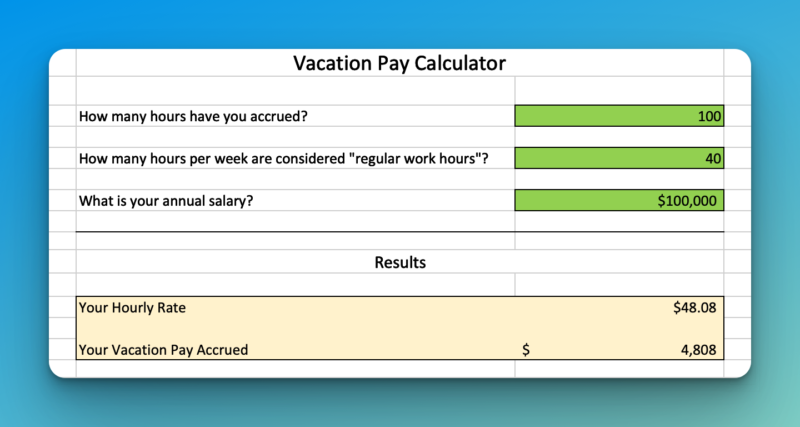Vacation Pay Calculator
Use this vacation pay calculator to determine how much your company owes you in vacation payouts.
Vacation Pay Calculator
Results
Vacation Pay Calculator Instructions
Follow these steps to use the leave payout calculator:
- “How many hours have you accrued?”
- Input the total number of vacation hours you have accrued up to the current date.
- If you don’t know, use our PTO accrual calculator to get the first output.
- “How many hours per week are considered ‘regular work hours’?”
- Specify what constitutes a full workweek in hours for your employment. This is used to calculate your hourly rate from the annual salary.
- The default is set to 40 hours.
- “What is your annual salary?”
- Enter your gross annual salary.
- This is used to find your hourly rate (and ultimately, how much you are owed in vacation hours).
The vacation pay calculator will determine how much you are owed in unused vacation/PTO pay.
How To Calculate Vacation Pay On Your Own
Below, you’ll find the steps to calculate your owed vacation pay.
Calculate the Hourly Rate:
- Hourly Rate = Annual Salary / (Regular Work Hours per Week × 52)
- 52 represents the number of weeks in a year, assuming you work every week.
Calculate the Vacation Pay Accrued:
- Vacation Pay Accrued = Accrued Hours × Hourly Rate
This gives the total amount you have accrued as vacation pay based on the hourly rate calculated from your salary.
How To Calculate Vacation Pay Owed In Excel
If you’d rather do the calculation on your own (with more control over the inputs), use our vacation pay Excel template.

Related Resources
Income & Salary Calculators
Here are a few other free calculators we’ve built that are closely related to our overtime calculator.
- PTO Accrual Calculator
- Salary To Hourly Calculator
- Hourly To Salary Calculator
- Work Hours Calculator
- Overtime Calculator
Paid Time Off Resources
Here are some additional resources you might find useful for managing your team’s time off policies:
- Unlimited PTO Policy Examples & Templates
- Unlimited PTO Is A Trap: Do This Instead
- 100 Companies With Unlimited PTO
- Back To Office After Vacation Email Templates
- PTO Request Emails
Disclaimer: This calculator is not legal advice. Please advise your HR or legal team first to determine the right work hour calculations and salaries depending on your type of organization, employee status, and labor laws in your state or country.
